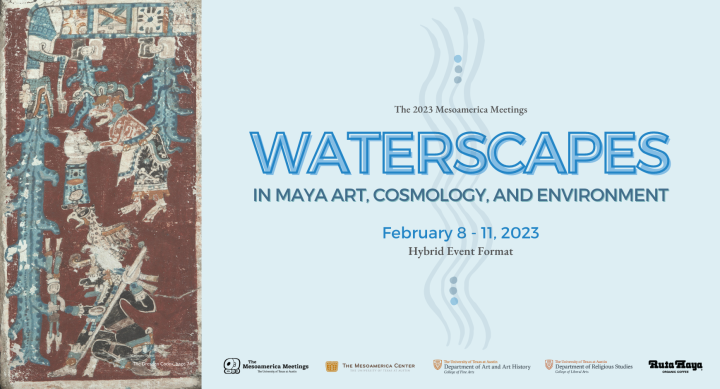

WATERSCAPES IN MAYA ART, COSMOLOGY, AND ENVIRONMENT
February 8-11, 2023
Conference Format: Hybrid
Organizers: David Stuart, Astrid Runggaldier, Milady Casco, Laura Gámez, Mallory Matsumoto, Katherine Schumann
The University of Texas at Austin, Austin, TX
Water’s centrality in human lives reflects its inherently ambiguous nature. Water is both a vital and a potentially lethal aspect of our world, one that humans need to live but are unable to control. As liquid, vapor or solid, it has a unique mobility and the capacity to shape its surrounding environment. Water is an especially acute concern today in the context of climate change; the Planet Texas 2050 initiative at UT Austin, for instance, centers water in its declaration of purpose to advance modern “adaptability and resilience” through interdisciplinary research. The 2023 Mesoamerica Meetings will explore these new insights and how researchers are driving the study of water in the Maya world, past and present, across the environmental social sciences and humanities.
Water surrounded the ancient Maya world and shaped its very existence, forming a broad landscape where oceans, springs, cenotes, rivers and bajos all converged. Methodologies ranging from underwater archaeology to water chemistry to terrestrial excavation shed light on climate history across the Maya region and how Maya communities have managed water access and the myriad resources that it hosts. Hydraulic landscapes were shaped by and often critical to the identity of the Maya communities who inhabited them. Communities throughout the Maya region experienced cycles of drought and (over-)abundance of water, which had the potential to exert significant pressure on existing political and social institutions. More predictable annual variations in rainfall are believed to have influenced agricultural but also military activity. At the same time, more irregular, extreme episodes of water scarcity did not necessarily foment political upheaval; they may have even reinforced existing hierarchies by allowing leaders to demonstrate their success in petitioning gods and ancestors for relief.
But water’s significance in Maya culture extends beyond its physical presence or absence in the world. Symbolism of water in the world of the humans and in the realm of the gods has been fundamental to Maya cosmology through its history, including water’s primordial role in creation and the deities identified with it. Water and its denizens are prominently visualized in material culture that survives from the ancient past and represented linguistically in ethnohistorical and ethnographic histories. Water could be both a place inhabited by a range of other-than-human beings and a liminal space through which humans forged a path forward, sometimes being transformed in the process. Research from the environmental humanities offers insight into how water was conceptualized and dealt with in the past, and how Indigenous Maya communities today continue to adapt to the fluctuating presence of water in their lands and daily lives.
Research on the significance of water among the ancient Maya continues to expand and touch on new themes, revealing its centrality to art, urbanism, religion, and worldview. Our conference will explore water in several ways – as a distinct material essence, as a changing feature over time, as a resource that was manipulated and channeled around places and things, and as a symbol of a realm parallel to the earth, where gods were born and where heroes were resurrected. The subject is broad, and we will be building upon various publications and discussions that have helped to shape recent research across archaeology, art, epigraphy, ethnohistory, geography and environmental studies.

